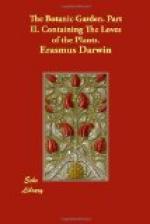[Adonis. l. 468. Many males and many females live together in the same flower. It may seem a solecism in language, to call a flower, which contains many of both sexes, an individual; and the more so to call a tree or shrub an individual, which consists of so many flowers. Every tree, indeed, ought to be considered as a family or swarm of its respective buds; but the buds themselves seem to be individual plants; because each has leaves or lungs appropriated to it; and the bark of the tree is only a congeries of the roots of all these individual buds. Thus hollow oak-trees and willows are often seen with the whole wood decayed and gone; and yet the few remaining branches flourish with vigour; but in respect to the male and female parts of a flower, they do not destroy its individuality any more than the number of paps of a sow, or the number of her cotyledons, each of which includes one of her young.
The society, called the Areoi, in the island of Otaheite, consists of about 100 males and 100 females, who form one promiscuous marriage.]
Pair
after pair, along his sacred groves
470 To Hymen’s fane the bright procession moves;
Each
smiling youth a myrtle garland shades,
And
wreaths of roses veil the blushing maids;
Light
joys on twinkling feet attend the throng,
Weave
the gay dance, or raise the frolic song;
475 —Thick, as they pass, exulting Cupids
fling
Promiscuous
arrows from the sounding string;
On
wings of gossamer soft Whispers fly,
And
the sly Glance steals side-long from the eye.
—As
round his shrine the gaudy circles bow,
480 And seal with muttering lips the faithless vow,
Licentious
Hymen joins their mingled hands,
And
loosely twines the meretricious bands.—
Thus
where pleased VENUS, in the southern main,
Sheds
all her smiles on Otaheite’s plain,
485 Wide o’er the isle her silken net she draws,
And
the Loves laugh at all, but Nature’s laws.”
Here
ceased the Goddess,—o’er the silent
strings
Applauding
Zephyrs swept their fluttering wings;
Enraptur’d
Sylphs arose in murmuring crowds
490 To air-wove canopies and pillowy clouds;
Each
Gnome reluctant sought his earthy cell,
And
each bright Floret clos’d her velvet bell.
Then,
on soft tiptoe, NIGHT approaching near
Hung
o’er the tuneless lyre his sable ear;
495 Gem’d with bright stars the still etherial
plain,
And
bad his Nightingales repeat the strain.
[Illustration: Apocynum androsaemifolium.]
ADDITIONAL NOTES:
P. 7. Additional note to Curcuma. These anther-less filaments seem to be an endeavour of the plant to produce more stamens, as would appear from some experiments of M. Reynier, instituted for another purpose: he cut away the stamens of many flowers, with design to prevent their fecundity, and in many instances the flower threw out new filaments from the wounded part of different lengths; but did not produce new anthers. The experiments were made on the geum rivale, different kinds of mallows, and the aechinops ritro. Critical Review for March, 1788.




